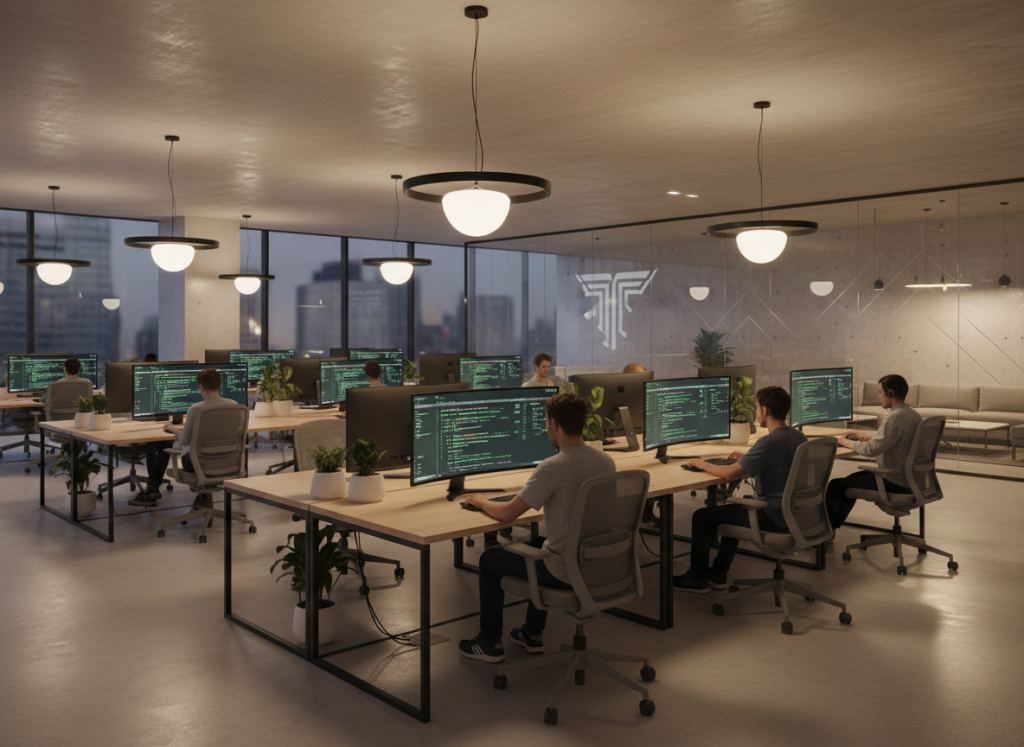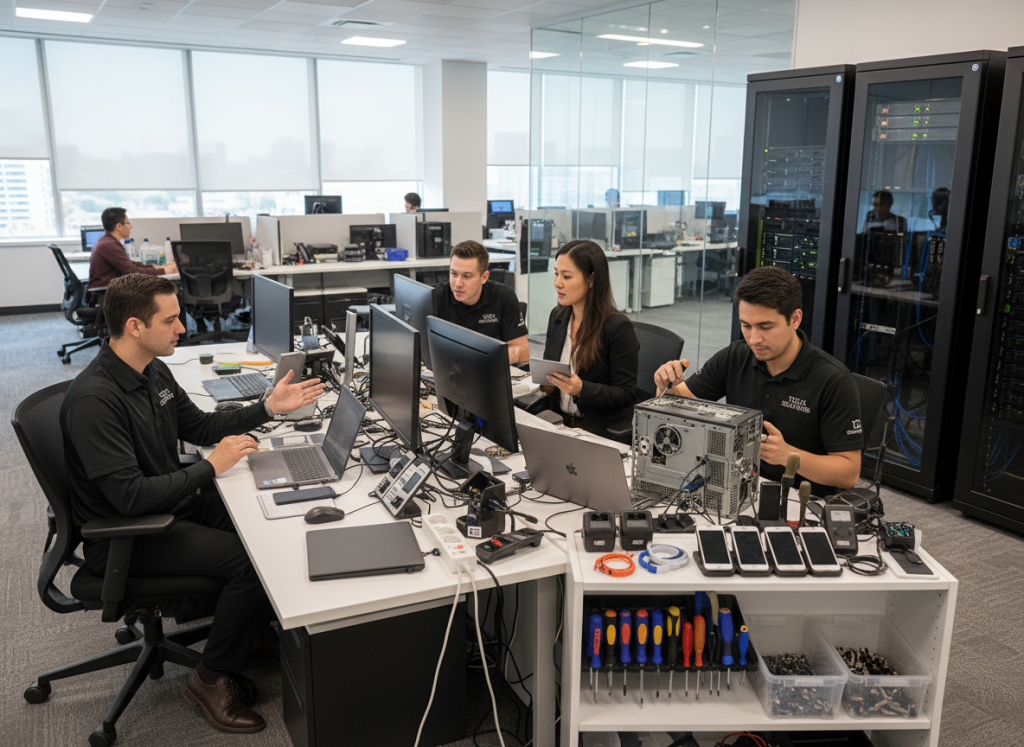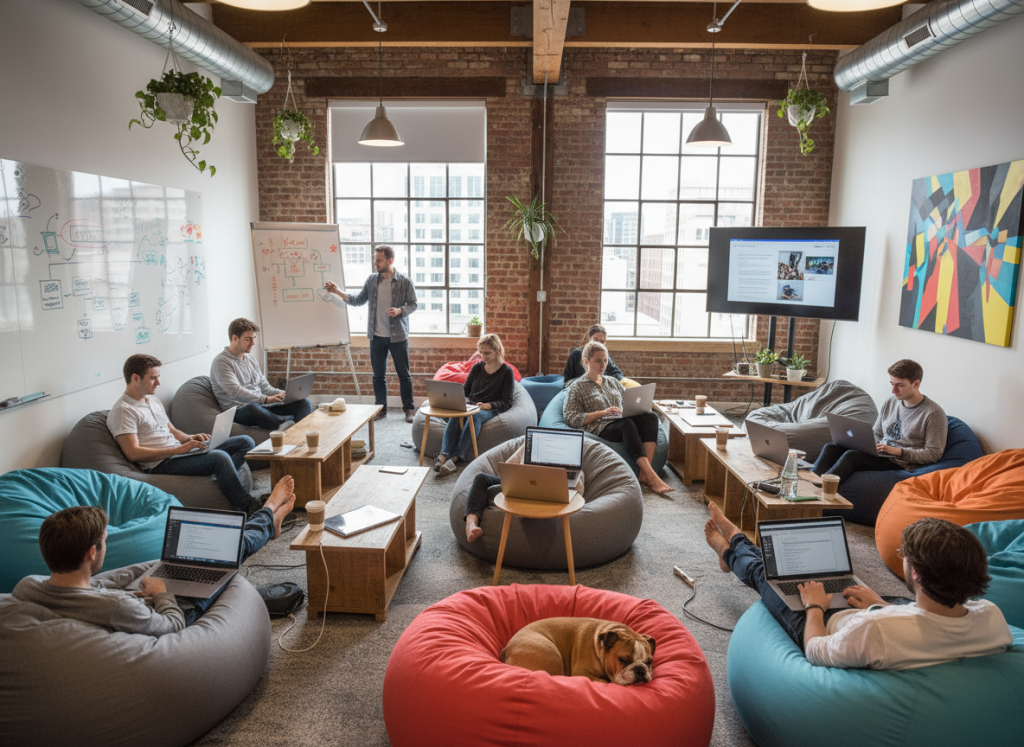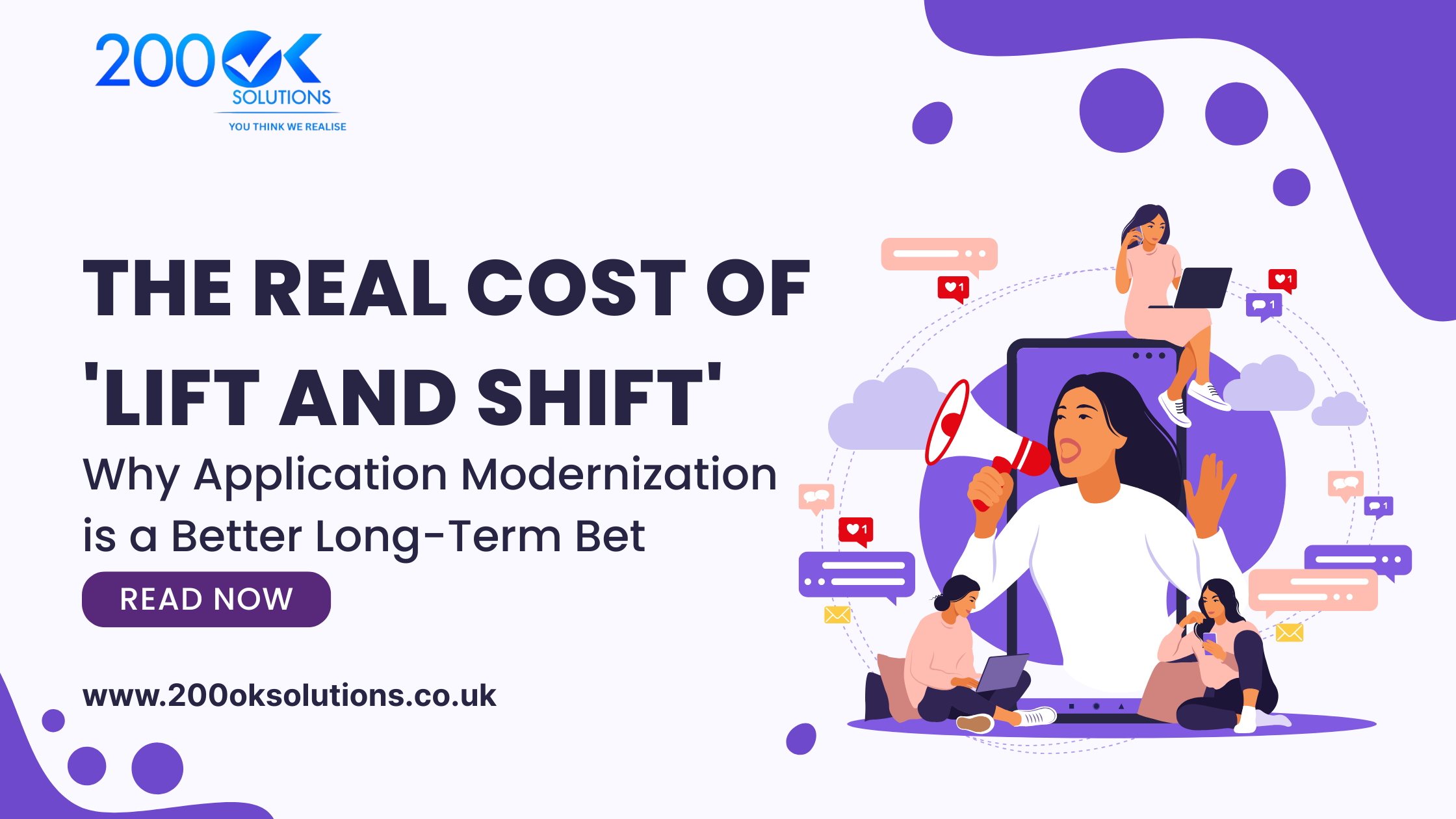Executive Summary
Lift and shift cloud migration may seem like the fastest route to the cloud, but enterprises are discovering it’s rarely the most cost-effective long-term strategy. While moving legacy applications “as-is” to cloud infrastructure can reduce upfront costs by 30-40%, application modernization delivers 3-5x better ROI over three years through reduced operational expenses, improved scalability, and enhanced business agility. This comprehensive guide explores the hidden costs of lift and shift migration, compares it against app re-engineering approaches, and provides a strategic roadmap for UK businesses planning their 2025 cloud migration initiatives.
What is Lift and Shift Cloud Migration?
Lift and shift, also known as “rehosting,” is a migration strategy where applications are moved from on-premises infrastructure to the cloud with minimal or no code changes. Think of it as relocating your office to a new building but keeping all the same furniture, filing systems, and workflows intact.
Key Characteristics of Lift and Shift:
- Minimal code modification during the migration process
- Applications retain their original architecture and dependencies
- Fastest time-to-cloud deployment (typically 3-6 months)
- Lower initial migration costs compared to refactoring apps
- Limited optimization for cloud native environments
- Maintains existing technical debt and architectural limitations

When Lift and Shift Makes Sense:
While this article focuses on why application modernization is superior long-term, lift and shift does have legitimate use cases:
- Emergency datacenter exits with tight deadlines
- Applications scheduled for retirement within 12-18 months
- Compliance-driven migrations requiring immediate cloud presence
- Temporary moves during broader digital transformation initiatives
- Testing cloud environments before committing to legacy modernization
The Hidden Costs of Lift and Shift Cloud Migration UK
UK enterprises often discover that lift and shift savings are largely illusory when examining total cost of ownership (TCO) beyond the initial migration phase.
1. Inefficient Resource Utilization
Legacy applications weren’t designed for cloud economics. They typically:
- Run on oversized virtual machines to match physical server specs
- Lack auto-scaling capabilities, requiring manual capacity planning
- Cannot leverage serverless or containerized architectures
- Waste 40-60% of provisioned cloud resources during off-peak hours
- Require expensive hybrid cloud UK configurations for optimal performance
Real Cost Example: A UK financial services firm discovered their lift and shift approach cost £180,000 annually in wasted cloud resources compared to properly optimized workloads.
2. Increased Operational Complexity
Moving legacy modernization problems to the cloud doesn’t eliminate them:
- Patching and maintenance become more complex in cloud environments
- Traditional monitoring tools may not integrate with cloud-native services
- Technical debt compounds with each passing year
- DevOps teams require dual expertise in legacy and cloud technologies
- Incident response times increase due to architectural mismatches
3. Licensing Pitfalls
Cloud costs for lift and shift often include unexpected licensing expenses:
- Bring-your-own-license (BYOL) models may not translate cost-effectively
- Database licensing in the cloud can cost 2-3x on-premises equivalents
- Software vendors charge premiums for cloud deployments
- Compliance requirements may mandate enterprise licensing tiers
- UK enterprise cloud migration strategies 2025 must account for post-Brexit licensing complexities

4. Performance Degradation
Applications designed for on-premises infrastructure frequently underperform in cloud environments:
- Network latency increases for chatty application architectures
- Storage I/O patterns optimized for SAN don’t translate to cloud storage
- Session affinity requirements limit cloud load balancing benefits
- Monolithic applications can’t leverage distributed cloud services
- User experience suffers, impacting business outcomes
5. Security and Compliance Gaps
Lift and shift pitfalls UK businesses face include:
- Legacy security models incompatible with cloud-native security services
- Increased attack surface without proper cloud security architecture
- Compliance frameworks requiring architectural changes post-migration
- Data residency requirements necessitating costly reconfigurations
- Inability to leverage cloud-native encryption and identity services
6. Missed Innovation Opportunities
Perhaps the greatest real cost of lift and shift cloud migration UK is opportunity cost:
- Cannot leverage AI/ML services requiring modern data architectures
- Limited ability to implement microservices or event-driven patterns
- Slow time-to-market for new features due to architectural constraints
- Competitive disadvantage against cloud-native competitors
- Reduced developer productivity and satisfaction
Why Application Modernization Better Than Lift Shift: The Long-Term Value Proposition
Application modernization encompasses multiple approaches to transforming legacy applications for cloud environments, from minor refactoring apps to complete rebuilds.
The Modernization Spectrum:
- Refactoring: Minor code changes to optimize for cloud
- Re-platforming: Changing underlying platform without altering core architecture
- Re-architecting: Significant structural changes to adopt cloud-native patterns
- Rebuilding: Complete application rewrite using modern frameworks
- Replacing: Adopting SaaS alternatives to custom applications
Compelling Benefits of App Re-engineering UK 2025:
Financial Advantages
- Reduced operational costs: 40-70% lower TCO over 3-5 years
- Optimized cloud spending: Pay only for resources actually consumed
- Lower licensing costs: Modern architectures often use open-source alternatives
- Improved resource efficiency: Auto-scaling and right-sizing capabilities
- Faster time-to-value: New features deploy 5-10x faster
ROI Example: A UK retail company invested £500,000 in application modernization versus £200,000 for lift and shift. After 18 months, they’d saved £450,000 in operational costs, achieving positive ROI while the lift and shift option continued incurring high ongoing expenses.

Technical Benefits
Modern applications leverage cloud native capabilities:
- Microservices architecture enables independent scaling and deployment
- Containerization with Kubernetes provides portability and efficiency
- Serverless computing eliminates infrastructure management overhead
- API-first design facilitates integration and ecosystem development
- Event-driven patterns improve responsiveness and scalability
- Cloud-native databases offer better performance at lower cost
Business Agility
App re-engineering transforms applications into competitive advantages:
- Deploy new features weekly instead of quarterly
- Scale instantly to meet demand fluctuations
- Respond rapidly to market changes and opportunities
- Enable data-driven decision making through modern analytics
- Support innovative business models and revenue streams
- Attract and retain top technical talent
Security and Compliance
Modernizing legacy apps UK costs benefits include enhanced security posture:
- Built-in cloud-native security services integration
- Zero-trust architecture implementation
- Automated compliance monitoring and reporting
- Granular access controls and identity management
- Enhanced data protection and encryption capabilities
- Reduced attack surface through microservices isolation
Lift and Shift vs App Re-engineering UK 2025: A Comprehensive Comparison
Initial Investment Comparison
| Factor | Lift and Shift | Application Modernization |
| Upfront Cost | £100K – £500K | £300K – £2M |
| Timeline | 3-6 months | 6-18 months |
| Resource Requirements | Infrastructure team | Full dev team + architects |
| Business Disruption | Minimal | Moderate (manageable) |
| Risk Level | Low short-term | Medium (mitigated with phasing) |
3-Year TCO Comparison (Mid-Sized UK Enterprise)
| Cost Category | Lift and Shift | Modernization | Savings |
| Initial Migration | £400K | £1.2M | -£800K |
| Year 1 Operations | £380K | £180K | £200K |
| Year 2 Operations | £420K | £165K | £255K |
| Year 3 Operations | £450K | £150K | £300K |
| Remediation Costs | £300K | £50K | £250K |
| Total 3-Year TCO | £1.95M | £1.745M | £205K |
Performance and Capability Metrics
Cloud costs efficiency (lower is better):
- Lift and Shift: 45-60% resource waste typical
- Modernization: 5-15% resource waste with proper optimization
Deployment frequency (higher is better):
- Lift and Shift: Quarterly releases (4x/year)
- Modernization: Weekly releases (50x/year)
Scalability (time to scale for demand):
- Lift and Shift: 30-60 minutes (manual intervention)
- Modernization: Seconds to minutes (automated)
Innovation velocity (new feature time-to-market):
- Lift and Shift: 3-6 months average
- Modernization: 2-4 weeks average
Hidden Costs Lift and Shift Migration UK: What Finance Teams Need to Know
Cost Category Breakdown
1. Compute Overprovisioning
- Impact: £50K-£200K annually per major application
- Cause: Right-sizing impossible without architectural changes
- Alternative: Modernized apps use 40-60% fewer compute resources
2. Data Transfer Costs
- Impact: £20K-£100K annually depending on architecture
- Cause: Chatty applications generate excessive inter-service traffic
- Alternative: Refactoring apps reduces data transfer by 60-80%
3. Storage Inefficiency
- Impact: £30K-£150K annually
- Cause: Legacy backup patterns and lack of data lifecycle management
- Alternative: Cloud-native storage strategies reduce costs 50-70%
4. Remediation and Rework
- Impact: £100K-£500K over 2-3 years
- Cause: Performance issues, security gaps, and compliance requirements force changes
- Alternative: Build it right from the start with legacy modernization
5. Lost Productivity
- Impact: £200K-£800K annually in developer time
- Cause: Working with legacy architectures slows development velocity
- Alternative: Modern platforms improve developer productivity 3-5x
6. Technical Debt Interest
- Impact: Compounds 10-20% annually
- Cause: Legacy code becomes increasingly difficult to maintain in cloud
- Alternative: Application modernization eliminates accumulated technical debt
Real-World UK Case Study: Retail Sector
Company Profile: Mid-sized UK retail chain with £200M annual revenue
Initial Decision: Lift and shift of 35 legacy applications
Year 1 Results:
- Migration cost: £380K (on budget)
- Cloud operations: £420K annually (80% over projections)
- Performance issues requiring remediation: £150K
- Lost revenue from 3 major outages: £280K
- Total Year 1 Cost: £1.23M
Modernization Alternative (modeled):
- Migration cost: £950K
- Cloud operations: £180K annually
- Zero performance issues (proper architecture)
- Zero outages (resilient design)
- Total Year 1 Cost: £1.13M
- Year 2-3 Savings: £640K
Result: Company initiated legacy app modernization roadmap UK in Year 2, essentially paying for migration twice.
When to Avoid Lift and Shift Cloud UK: Decision Framework
Red Flags for Lift and Shift
❌ Applications requiring significant scaling
- High traffic variability (2x or more fluctuation)
- Growth projections exceeding 50% over 2 years
- Geographic expansion planned
❌ Legacy architectures with known limitations
- Monolithic applications over 100K lines of code
- Applications with frequent performance issues on-premises
- Systems with high operational maintenance burden
❌ Compliance-sensitive workloads
- Financial services applications requiring audit trails
- Healthcare systems with strict data residency requirements
- Applications subject to GDPR with data processing changes needed
❌ Business-critical applications with innovation requirements
- Customer-facing applications requiring rapid feature updates
- Applications needing AI/ML integration
- Systems requiring modern API ecosystems
❌ Applications with aging technology stacks
- Unsupported programming languages or frameworks
- Dependencies on obsolete middleware or databases
- Applications using Windows Server 2012 or earlier

Green Lights for Lift and Shift
✅ Short-term tactical moves
- Datacenter contract expiring within 12 months
- Applications scheduled for retirement or replacement
- Emergency situations requiring immediate cloud presence
✅ Stable, low-change applications
- Minimal feature development planned
- Mature codebase with infrequent updates
- Low business criticality
✅ Stepping stone strategy
- Phase 1 of planned modernization initiative
- Learning exercise before larger migration strategy commitment
- Testing environment for cloud operations capabilities
Application Refactoring Costs vs Lift Shift UK: Detailed ROI Analysis
Investment Timeline Comparison
Lift and Shift Investment Pattern
- Month 0-6: Initial migration (£400K)
- Year 1: Stabilization and optimization attempts (£200K)
- Year 2: Remediation and performance fixes (£300K)
- Year 3: Architecture debt forces modernization anyway (£800K)
- Total 3-Year Investment: £1.7M
Application Modernization Investment Pattern
- Month 0-12: Phased modernization (£1.2M)
- Year 1: Minor optimization (£50K)
- Year 2: Feature enhancements (£80K)
- Year 3: Continuous improvement (£80K)
- Total 3-Year Investment: £1.41M
Break-Even Analysis
Typical break-even point: 18-24 months
Factors accelerating break-even:
- High current infrastructure costs
- Significant scaling requirements
- Rapid feature development needs
- Multiple applications in modernization portfolio
- Availability of modern development frameworks
Factors extending break-even:
- Simple, stable applications
- Limited current infrastructure costs
- Low operational complexity
- Small development teams
- Extensive custom code requiring rewrite
Cost Savings App Re-engineering UK 2025
Operational savings categories:
- Infrastructure: 40-60% reduction
- Licensing: 30-50% reduction
- Operations labor: 35-55% reduction
- Incident management: 60-80% reduction
- Compliance/audit: 40-60% reduction
Additional value creation:
- Revenue acceleration: 15-30% from faster time-to-market
- Customer satisfaction: 20-40% improvement from better performance
- Developer retention: 25-35% improvement reducing recruitment costs
- Innovation capacity: 3-5x increase in new features delivered
UK Enterprise Cloud Migration Strategies 2025: Best Practices

Strategic Framework for Decision-Making
1. Application Portfolio Assessment
Categorize applications across two dimensions:
Business Value (High/Medium/Low):
- Revenue generation impact
- Customer experience criticality
- Competitive differentiation
- Strategic importance
Technical Feasibility (Easy/Moderate/Complex):
- Architecture modularity
- Code quality and documentation
- Team expertise and availability
- Technology stack currency
2. The Modernization Matrix
| Business Value | Easy to Modernize | Moderate Effort | Complex |
| High | Modernize first | Modernize early | Phased modernization |
| Medium | Quick wins | Evaluate case-by-case | Consider replacement |
| Low | Lift and shift or retire | Lift and shift | Retire or replace |
3. Phased Approach for Large Portfolios
Phase 1: Foundation (Months 0-6)
- Establish cloud landing zones and governance
- Migrate non-critical applications for learning
- Build cloud competency within teams
- Deploy monitoring and FinOps tools
Phase 2: Quick Wins (Months 6-12)
- Modernize high-value, low-complexity applications
- Demonstrate ROI to stakeholders
- Refine processes and tooling
- Build momentum and confidence
Phase 3: Strategic Transformation (Months 12-24)
- Tackle complex, high-value applications
- Implement cloud native patterns at scale
- Optimize costs and operations
- Measure and communicate business outcomes
Phase 4: Continuous Optimization (Ongoing)
- Regular architecture reviews
- Cost optimization initiatives
- Adoption of emerging cloud services
- Skills development and training
Hybrid Cloud vs Lift and Shift UK: The Integrated Approach
Many UK enterprises find success with hybrid cloud UK strategies that combine:
- Cloud-native applications for customer-facing workloads
- Modernized legacy systems for core business processes
- Retained on-premises systems for specific compliance or performance needs
- SaaS replacements for commodity functions
Benefits of hybrid approach:
- Flexibility to optimize each workload individually
- Reduced risk through gradual transformation
- Maintains business continuity during transition
- Leverages existing infrastructure investments
- Accommodates varying team readiness levels
Key success factors:
- Robust connectivity between environments
- Unified management and monitoring
- Consistent security and governance
- Clear workload placement criteria
- Strong integration architecture
Legacy App Modernization Roadmap UK: Step-by-Step Implementation Guide
Step 1: Discovery and Assessment (4-8 weeks)
Application inventory and documentation:
- Map all applications, dependencies, and integrations
- Document current architecture and technology stacks
- Identify business owners and technical SMEs
- Catalog data flows and storage requirements
- Review security and compliance requirements
Assessment activities:
- Run automated code analysis tools
- Conduct architecture review sessions
- Interview development and operations teams
- Analyze usage patterns and performance metrics
- Review incident history and operational issues
Deliverables:
- Application portfolio catalog
- Technical debt assessment
- Modernization suitability scoring
- Preliminary effort and cost estimates
- Risk assessment for each application
Step 2: Strategy Definition (2-4 weeks)
Strategic decisions:
- Select target cloud platform(s) and services
- Define modernization patterns for each application category
- Establish governance and standards
- Create business case and ROI projections
- Secure executive sponsorship and funding
Architecture definition:
- Design target state reference architectures
- Define cloud native patterns and standards
- Plan data migration and integration strategies
- Establish security and compliance frameworks
- Design CI/CD and DevOps processes
Deliverables:
- Modernization strategy document
- Target architecture blueprints
- Implementation roadmap with phases
- Business case and budget approval
- Governance framework
Step 3: Pilot Application (8-16 weeks)
Pilot selection criteria:
- Medium business value and complexity
- Supportive business owner
- Available development team
- Clear success criteria
- Representative technical challenges
Pilot objectives:
- Validate modernization approach
- Train teams on cloud technologies
- Establish processes and tooling
- Identify and resolve challenges early
- Build confidence for larger initiatives
Success metrics:
- Migration within budget and timeline
- Performance improvements demonstrated
- Operational metrics baseline established
- Team satisfaction and capability growth
- Lessons learned documented

Step 4: Scaled Implementation (12-36 months)
Wave-based approach:
Wave 1 (Months 4-9): 3-5 applications
- Focus on quick wins and learning
- Establish patterns and reusable components
- Build team capabilities
- Communicate early successes
Wave 2 (Months 9-18): 10-15 applications
- Increase velocity and scope
- Leverage established patterns
- Introduce automation
- Optimize costs
Wave 3 (Months 18-30): 20+ applications
- Full-scale modernization execution
- Factory approach with specialized teams
- Advanced cloud-native patterns
- Business transformation integration
Wave 4 (Months 30-36): Complex applications
- Tackle most challenging applications
- Apply lessons from all previous waves
- Complete portfolio transformation
- Document transformation journey
Step 5: Optimization and Continuous Improvement (Ongoing)
Optimization activities:
- Regular FinOps reviews and cost optimization
- Performance tuning and right-sizing
- Security posture improvements
- Adoption of new cloud services
- Architecture evolution
Capability building:
- Ongoing training and certification
- Knowledge sharing and documentation
- Community of practice development
- Innovation time for exploration
- Partnership with cloud providers
Why Refactor Over Lift and Shift UK Enterprises: Industry-Specific Considerations

Financial Services
Regulatory requirements make application modernization essential:
- FCA regulations require robust audit trails (easier with modern architectures)
- PSD2 and Open Banking demand API-first approaches
- GDPR necessitates data processing transparency
- Real-time fraud detection requires modern analytics capabilities
Competitive pressures:
- Fintech challengers using cloud-native architectures
- Customer expectations for digital-first experiences
- Need for rapid product innovation
- Cost pressures requiring operational efficiency
Modernization priorities:
- Core banking systems to microservices
- Payment processing with event-driven architecture
- Customer portals with modern UX frameworks
- Analytics platforms for AI/ML integration
Healthcare and Life Sciences
Patient care quality depends on modern applications:
- Real-time access to patient data across settings
- Integration with medical devices and wearables
- Telehealth capabilities requiring scalability
- Research applications requiring high-performance computing
Regulatory landscape:
- NHS Digital standards for interoperability
- Data protection requirements exceeding GDPR
- Clinical safety requirements (DCB0129/DCB0160)
- Medicine and Healthcare products Regulatory Agency (MHRA) compliance
Modernization imperatives:
- Electronic health records modernization
- Clinical decision support systems
- Population health analytics
- Patient engagement applications
Retail and E-Commerce
Customer experience is the primary driver:
- Milliseconds of latency impact conversion rates
- Personalization requires real-time data processing
- Omnichannel consistency demands integrated architecture
- Seasonal scaling needs cloud-native elasticity
Operational efficiency:
- Inventory management across channels
- Supply chain optimization
- Dynamic pricing algorithms
- Fraud prevention and security
Modernization focus:
- E-commerce platforms to headless commerce
- POS systems to cloud-connected architecture
- Customer data platforms for unified view
- Supply chain visibility applications
Manufacturing and Industrial
Industry 4.0 transformation requires modern platforms:
- IoT device integration at scale
- Predictive maintenance analytics
- Digital twin implementations
- Supply chain digitalization
Operational technology (OT) convergence:
- Integration of factory floor systems with enterprise applications
- Real-time production monitoring and optimization
- Quality management system modernization
- Environmental and sustainability reporting
Cloud Migration ROI Lift Shift vs Modernization UK: CFO Perspective

Financial Modeling Approach
Key Metrics for Evaluation
Total Cost of Ownership (TCO):
TCO = Initial Migration + (Annual Operations × Years) + Remediation + Opportunity Costs
Return on Investment (ROI):
ROI = (Gains – Investment) / Investment × 100%
Gains = Cost Savings + Revenue Acceleration + Risk Mitigation Value
Net Present Value (NPV):
NPV = Σ (Cash Flow / (1 + Discount Rate)^Year) – Initial Investment
Payback Period:
Time required for cumulative benefits to exceed cumulative costs
Detailed Financial Comparison: 5-Year Projection
Scenario: UK manufacturing company, £500M revenue, 40 legacy applications
Lift and Shift Financial Model
| Year | Migration | Operations | Remediation | Lost Opportunity | Total |
| 0 | £1.2M | – | – | – | £1.2M |
| 1 | – | £850K | £300K | £400K | £1.55M |
| 2 | – | £920K | £500K | £600K | £2.02M |
| 3 | – | £980K | £400K | £800K | £2.18M |
| 4 | – | £1.05M | £600K | £1M | £2.65M |
| 5 | – | £1.12M | £800K | £1.2M | £3.12M |
| Total | £1.2M | £4.92M | £2.6M | £4M | £12.72M |
Application Modernization Financial Model
| Year | Migration | Operations | Enhancement | Revenue Impact | Total |
| 0 | £3.5M | – | – | – | £3.5M |
| 1 | – | £350K | £200K | +£800K | -£250K |
| 2 | – | £320K | £250K | +£1.2M | -£630K |
| 3 | – | £300K | £300K | +£1.5M | -£900K |
| 4 | – | £280K | £300K | +£2M | -£1.42M |
| 5 | – | £260K | £300K | +£2.5M | -£1.94M |
| Total | £3.5M | £1.51M | £1.35M | +£8M | £-1.64M |
Net Benefit of Modernization: £14.36M over 5 years
Risk-Adjusted Financial Analysis
Lift and Shift Risk Factors:
- 30% probability of major performance issues (£500K impact)
- 40% probability of security incident (£1M+ impact)
- 60% probability of requiring remediation (£500K-£2M)
- 50% probability of competitive disadvantage (revenue impact)
Expected Value Calculation:
Lift and Shift EV = Base Cost + (Σ Risk Probability × Risk Impact)
= £12.72M + £2.1M risk premium
= £14.82M
Modernization Risk Factors:
- 20% probability of timeline overrun (£500K impact)
- 10% probability of adoption challenges (£300K impact)
- 5% probability of technical issues (£200K impact)
Expected Value Calculation:
Modernization EV = Base Cost + (Σ Risk Probability × Risk Impact) – Revenue Benefits
= £6.36M + £240K risk premium – £8M benefits
= £-1.4M (net positive)
Value Beyond Direct Costs
Intangible benefits of application modernization:
- Developer Productivity and Retention
- 30% improvement in feature delivery velocity
- 40% reduction in recruitment needs
- Value: £500K-£1M annually
- Customer Satisfaction
- 25% improvement in NPS scores
- 15% reduction in churn
- Value: £2M-£5M annually (revenue retention)
- Business Agility
- 5x faster time-to-market for innovations
- Ability to respond to market changes
- Value: Competitive positioning (difficult to quantify)
- Risk Mitigation
- Reduced security vulnerability exposure
- Improved compliance posture
- Value: £1M-£10M (avoiding incidents)
- M&A Readiness
- Modern technology stack increases company valuation
- Easier integration with acquisition targets
- Value: 10-20% higher enterprise value
Practical Implementation: Modernizing Legacy Apps UK Costs Benefits
Cost Structure Breakdown
Application Modernization Investment Categories
1. Assessment and Planning (5-10% of total)
- Architecture assessment: £50K-£150K
- Portfolio analysis: £30K-£80K
- Strategy development: £40K-£100K
- Total: £120K-£330K
2. Infrastructure and Platform (15-20%)
- Cloud landing zone setup: £100K-£250K
- CI/CD pipeline development: £80K-£200K
- Monitoring and observability: £60K-£150K
- Security and compliance tooling: £80K-£200K
- Total: £320K-£800K
3. Application Development (50-60%)
- Architecture redesign: £200K-£600K per major application
- Code refactoring/rewriting: £300K-£1M per major application
- Integration development: £100K-£300K per major application
- Testing and quality assurance: £150K-£400K per major application
- Total: £750K-£2.3M per major application
4. Data Migration (10-15%)
- Data architecture design: £50K-£150K
- Migration tooling: £40K-£100K
- Data quality and cleansing: £80K-£250K
- Migration execution: £100K-£300K
- Total: £270K-£800K
5. Training and Change Management (5-10%)
- Team training programs: £80K-£200K
- Documentation development: £40K-£100K
- Change management: £60K-£150K
- Total: £180K-£450K
Typical UK Enterprise Modernization Budget
Small Enterprise (£10M-£50M revenue, 5-10 applications):
- Investment: £500K-£1.5M
- Timeline: 9-15 months
- Team: 8-15 people
Mid-Market (£50M-£500M revenue, 10-30 applications):
- Investment: £1.5M-£5M
- Timeline: 12-24 months
- Team: 20-40 people
Large Enterprise (£500M+ revenue, 30+ applications):
- Investment: £5M-£20M
- Timeline: 18-36 months
- Team: 50-100+ people
Funding Models
1. Capital Expenditure (CapEx)
- Traditional upfront investment
- Depreciated over 3-5 years
- Requires significant initial budget approval
- Suitable for well-defined scopes
2. Operational Expenditure (OpEx)
- Cloud-native consumption model
- Pay-as-you-go for cloud services
- Easier to secure ongoing funding
- Better alignment with business value delivery
3. Hybrid CapEx/OpEx
- Initial platform investment as CapEx
- Ongoing modernization and operations as OpEx
- Balanced approach for most enterprises
- Flexibility for portfolio approach
4. Outcome-Based Funding
- Tie funding to business value delivery
- Stage-gate approvals based on results
- Requires strong governance
- Reduces risk of overinvestment

FAQ: Common Questions About Cloud Migration Strategies
Q1: How long does application modernization take compared to lift and shift?
Lift and shift timeline: 3-6 months for initial migration, but remediation often extends 18-24 months
Application modernization timeline: 6-18 months for proper modernization, but delivers lasting value immediately
The key difference is that modernization is truly complete when finished, while lift and shift begins a cycle of ongoing remediation that can extend indefinitely.
Q2: Can we do both – lift and shift now, then modernize later?
This “two-step” approach often seems appealing but typically costs 30-50% more than modernizing from the start because you’re essentially paying for migration twice. The exceptions where this makes sense:
- Datacenter contracts expiring before modernization can complete
- Applications retiring within 18 months anyway
- Using lift and shift as a learning exercise for 1-2 non-critical applications
For most business-critical applications, why refactor over lift and shift UK enterprises are choosing is because doing it right once is more cost-effective.
Q3: What if we don’t have the internal skills for application modernization?
UK enterprises have several options:
- Partner with specialists: Firms like 200OK Solutions provide expertise and accelerators
- Hybrid teams: Combine internal knowledge with external specialists
- Training programs: Invest in upskilling existing teams (12-18 month timeframe)
- Managed services: Leverage cloud provider professional services
- Acquire talent: Hire cloud-native developers (though competitive market)
Most successful UK enterprise cloud migration strategies 2025 combine internal teams (for business knowledge) with external partners (for technical expertise and acceleration).
Q4: How do we justify the higher upfront costs of modernization to executives?
Focus your business case on:
- Total 3-5 year costs rather than initial investment
- Revenue impact from faster time-to-market and better customer experience
- Risk mitigation value of avoiding security incidents and compliance failures
- Competitive positioning against cloud-native competitors
- NPV analysis showing modernization’s superior long-term value
Use the financial models provided earlier in this article to demonstrate that application modernization typically achieves positive ROI within 18-24 months.
Q5: What happens to our existing IT staff during modernization?
Application modernization creates opportunities for existing teams:
- Reskilling programs: Train traditional developers in cloud-native technologies
- Hybrid roles: Leverage legacy knowledge during transition period
- New positions: Create roles in DevOps, SRE, and cloud architecture
- Career advancement: Modern skills improve employability and satisfaction
- Reduced burden: Eliminate time spent on legacy system maintenance
Most UK enterprises see improved retention during modernization as teams are energized by working with modern technologies.
Q6: How do we handle compliance and security during the modernization process?
Best practices for secure modernization:
- Security by design: Build security into architecture from the start
- Compliance mapping: Identify requirements early and design controls
- Incremental migration: Move data in phases with validation gates
- Zero-trust architecture: Implement modern identity and access controls
- Automated compliance: Use cloud-native tools for continuous monitoring
- Third-party audits: Engage specialists for regulatory requirements
Modern cloud native architectures actually improve security posture compared to legacy systems when properly implemented.
Q7: Should we modernize everything, or are some applications better left as-is?
Use the Modernization Matrix provided earlier in this article. Generally:
- Modernize: High business value applications, frequently changing applications, scaling requirements
- Consider lift and shift: Low business value, stable applications, retiring soon
- Replace with SaaS: Commodity functions like email, CRM, HR systems
- Retire: Redundant or obsolete applications
A typical portfolio might be: 40% modernize, 30% replace with SaaS, 20% lift and shift, 10% retire.
Q8: What are the biggest risks in application modernization projects?
Top risks and mitigation strategies:
- Scope creep → Strict governance and phased approach
- Skills gaps → Early training and external partnerships
- Business disruption → Parallel run periods and incremental cutover
- Cost overruns → Detailed planning and contingency budgets (15-20%)
- Stakeholder resistance → Strong change management and communication
- Technical challenges → Proof of concepts and pilot applications
Well-planned legacy modernization projects have 75-85% on-time, on-budget success rates.
Q9: How do we measure success beyond just technical metrics?
Comprehensive success metrics:
Financial:
- Total cost of ownership reduction
- ROI achievement vs. projections
- Cost per transaction/user
Technical:
- Application performance (response time, throughput)
- System availability and reliability
- Deployment frequency and lead time
- Mean time to recovery (MTTR)
Business:
- Time-to-market for new features
- Customer satisfaction scores
- Revenue impact from digital initiatives
- Market share vs. competitors
Organizational:
- Developer satisfaction and retention
- Skills development and certifications
- Innovation metrics (experiments run, ideas implemented)
Q10: What about vendor lock-in concerns with cloud-native modernization?
Strategies to minimize lock-in:
- Multi-cloud architecture: Design for portability from the start
- Container-based deployments: Use Kubernetes for cloud-agnostic orchestration
- Open-source technologies: Prefer open standards over proprietary services
- Abstraction layers: Build interfaces between application and cloud services
- Data portability: Design with data export and migration in mind
However, some cloud native service integration actually provides competitive advantage and shouldn’t be avoided solely due to lock-in concerns. The key is making informed trade-off decisions.
Case Studies: Real-World Application Modernization Success in the UK

Case Study 1: Financial Services – Core Banking Transformation
Company: Regional UK bank (£2B assets)
Challenge:
- 25-year-old core banking system unable to support digital initiatives
- Considering lift and shift to reduce datacenter costs
- Customer expectations for mobile-first banking
- Regulatory pressure for Open Banking compliance
Decision: Application modernization with microservices architecture
Implementation (18 months):
- Decomposed monolithic system into 45 microservices
- Implemented event-driven architecture for real-time processing
- Built API layer for third-party integrations
- Deployed on hybrid cloud UK infrastructure
Investment: £4.2M
Results after 2 years:
- 65% reduction in operational costs (£1.8M annually)
- 90% improvement in feature delivery speed (weekly vs. quarterly releases)
- 40% increase in digital customer acquisition
- Zero unplanned downtime in 18 months post-launch
- Full PSD2 compliance with API marketplace
ROI: Achieved positive ROI in 16 months; £3.2M net benefit by year 2
Key Learning: “We considered lift and shift to save £2M upfront, but would have lost £5M in competitive opportunities. Modernizing legacy apps UK costs benefits far exceeded our projections.” – CTO
Case Study 2: Retail – E-Commerce Platform Overhaul
Company: UK fashion retailer (£180M revenue, 250 stores)
Challenge:
- E-commerce platform struggling during peak shopping periods
- 40% cart abandonment rate due to performance issues
- Unable to implement personalization features
- High infrastructure costs with poor utilization
Initial Plan: Lift and shift estimated at £300K
Revised Approach: Application modernization with cloud-native architecture
Implementation (12 months):
- Rebuilt platform with headless commerce architecture
- Implemented containerized microservices
- Integrated AI-powered personalization engine
- Serverless backend for auto-scaling
Investment: £1.1M
Results after 18 months:
- 80% reduction in peak period infrastructure costs
- 25% decrease in cart abandonment rate
- 45% increase in online revenue (£18M additional)
- 3x improvement in page load times
- Weekly feature releases vs. quarterly previously
ROI: £6.8M net benefit in 18 months
What Changed Their Mind: Performance testing showed lift and shift would still struggle during peak periods, requiring expensive over-provisioning year-round. Cloud native auto-scaling eliminated this waste.
Case Study 3: Manufacturing – IoT and Analytics Platform
Company: UK industrial equipment manufacturer (£420M revenue)
Challenge:
- Legacy ERP and production systems couldn’t integrate with IoT sensors
- Missed opportunities in predictive maintenance services
- Competitors offering data-driven value-added services
- Complex on-premises infrastructure costing £2M annually
Initial Consideration: Lift and shift for £800K
Final Decision: App re-engineering with IoT and analytics focus
Implementation (24 months, phased):
- Phase 1: Cloud data lake for IoT sensor data
- Phase 2: Modernized production planning system
- Phase 3: Customer-facing predictive maintenance portal
- Phase 4: AI/ML models for optimization
Investment: £3.8M
Results after 3 years:
- £8M new recurring revenue from predictive maintenance subscriptions
- 60% reduction in unplanned equipment downtime
- £1.2M annual savings in infrastructure costs
- New business model enabling equipment-as-a-service
- Competitive differentiation in market
ROI: £12.4M cumulative benefit by year 3
CEO Quote: “Lift and shift would have saved us money but cost us our competitive future. Application modernization transformed us from equipment seller to service provider.”
Case Study 4: Healthcare – Patient Management System
Company: NHS Trust serving 800K patients
Challenge:
- Multiple disconnected legacy systems (25+ applications)
- Patient data fragmented across systems
- Inability to support integrated care initiatives
- High maintenance costs (£3.5M annually)
Strategy: Legacy app modernization roadmap UK over 30 months
Implementation Approach:
- Created unified patient data platform
- Modernized clinical applications one specialty at a time
- Integrated with NHS Digital services
- Implemented FHIR standards for interoperability
Investment: £6.2M (including NHS Digital Transformation funding)
Results after 2.5 years:
- Complete patient record accessible across all care settings
- 35% reduction in duplicate tests and procedures
- 50% decrease in administrative burden on clinicians
- £2.8M annual savings in operational costs
- Improved patient outcomes through care coordination
Clinical Impact: Clinicians now spend 90 minutes more per week on patient care vs. system navigation
Why Not Lift and Shift: Integration between disconnected systems would have remained impossible, missing the entire point of the digital transformation.
Tools and Technologies for Successful Application Modernization

Assessment and Planning Tools
Application Discovery:
- AWS Application Discovery Service: Automated infrastructure and application mapping
- Azure Migrate: Assessment and migration planning for Azure
- Google Cloud Migration Center: Portfolio analysis and planning
- Cloudamize: Analytics-driven optimization recommendations
- CAST Application Intelligence Platform: Technical debt quantification
Code Analysis:
- SonarQube: Code quality and security vulnerability analysis
- BlackDuck: Open source license and security scanning
- NDepend: .NET architecture and complexity analysis
- Structure101: Architecture visualization and dependency analysis
Modernization Platforms and Frameworks
Containerization:
- Docker: Container packaging and deployment
- Kubernetes: Container orchestration at scale
- Red Hat OpenShift: Enterprise Kubernetes platform
- Rancher: Multi-cluster Kubernetes management
Microservices Frameworks:
- Spring Boot: Java microservices (popular in UK enterprises)
- Node.js with Express: Lightweight JavaScript services
- .NET Core: Microsoft stack modernization
- Python Flask/FastAPI: Data-centric applications
API Management:
- Kong: Open-source API gateway
- Apigee: Enterprise API management (Google Cloud)
- Azure API Management: Microsoft ecosystem integration
- AWS API Gateway: Serverless-friendly option
Cloud-Native Services
Compute:
- AWS Lambda / Azure Functions / Google Cloud Functions: Serverless computing
- AWS ECS/EKS: Container services
- Azure Container Apps: Simplified container deployment
- Google Cloud Run: Container-based serverless
Databases:
- Amazon Aurora: MySQL/PostgreSQL-compatible managed database
- Azure Cosmos DB: Multi-model globally distributed database
- Google Cloud Spanner: Horizontally scalable SQL database
- MongoDB Atlas: Managed NoSQL database
Messaging and Events:
- Amazon SQS/SNS: Managed message queuing
- Azure Service Bus: Enterprise messaging
- Apache Kafka: Event streaming platform
- Google Pub/Sub: Scalable messaging service
DevOps and CI/CD
Version Control and CI/CD:
- GitHub Actions: Integrated CI/CD with GitHub
- GitLab CI/CD: Full DevOps platform
- Azure DevOps: Microsoft-centric toolchain
- Jenkins: Open-source automation server
Infrastructure as Code:
- Terraform: Multi-cloud infrastructure provisioning
- AWS CloudFormation: AWS-native IaC
- Pulumi: Programming language-based IaC
- Ansible: Configuration management and automation
Observability:
- Datadog: Comprehensive monitoring and analytics
- New Relic: Application performance monitoring
- Elastic Stack: Log aggregation and analysis
- Prometheus + Grafana: Open-source monitoring stack
Migration Tools
Data Migration:
- AWS Database Migration Service: Continuous data replication
- Azure Database Migration Service: Microsoft database migrations
- Striim: Real-time data integration
- Talend: Data integration and ETL
Application Migration:
- AWS Migration Hub: Centralized migration tracking
- Azure Migrate: End-to-end migration solution
- CloudEndure: Continuous replication-based migration
- Carbonite Migrate: Cross-platform migration
The Future of Application Modernization: 2025 and Beyond
Emerging Trends Shaping UK Cloud Strategies

1. AI-Assisted Modernization
AI and ML technologies are accelerating application modernization:
- Automated code conversion: AI tools translate legacy code to modern languages
- Architecture recommendations: ML analyzes codebases to suggest optimal patterns
- Test generation: Automated test creation for legacy systems
- Documentation creation: AI-generated technical documentation
UK enterprises adopting:
- GitHub Copilot for modernization coding assistance
- AWS CodeGuru for automated code reviews
- Azure AI-powered migration assessments
2. Low-Code/No-Code Modernization
Citizen developer platforms enabling faster modernization:
- Faster development: 5-10x speed improvements for certain application types
- Lower costs: Reduced need for specialized developers
- Business alignment: Business users directly contribute to modernization
- Limitations: Not suitable for complex or performance-critical systems
Leading platforms:
- Microsoft Power Platform
- Salesforce Lightning
- OutSystems
- Mendix
3. FinOps and Cost Optimization
Cloud cost management becoming critical:
- Real-time cost visibility: Instant feedback on architectural decisions
- Automated optimization: AI-driven resource right-sizing
- Chargeback models: Business unit accountability for costs
- Sustainability metrics: Carbon footprint tracking alongside costs
Best practices for 2025:
- FinOps team embedded in modernization programs from day one
- Cost optimization KPIs alongside functional requirements
- Regular architecture reviews for efficiency improvements
4. Serverless-First Architecture
Serverless computing becoming default for many workloads:
- Benefits: Zero infrastructure management, automatic scaling, pay-per-use
- Maturity: Enterprise-ready with improved cold start times and debugging
- Adoption: 60%+ of new UK enterprise applications using serverless components
Ideal use cases:
- API backends and microservices
- Event-driven processing
- Scheduled batch jobs
- Variable traffic applications
5. Edge Computing Integration
Distributed computing complementing cloud native architectures:
- Use cases: IoT processing, low-latency applications, data sovereignty
- Architecture: Hybrid edge-cloud patterns
- Benefits: Reduced latency, bandwidth optimization, resilience
UK sectors leading adoption:
- Manufacturing (IoT and Industry 4.0)
- Retail (in-store experiences)
- Healthcare (real-time patient monitoring)
- Financial services (low-latency trading)
6. Sustainability and Green Cloud
Environmental considerations influencing migration strategy:
- Carbon-aware architecture: Workload scheduling for renewable energy availability
- Efficient coding practices: Optimization reducing compute needs
- Right-sizing: Eliminating waste to reduce environmental impact
- Provider selection: Choosing cloud regions with renewable energy
UK regulatory pressures:
- Corporate sustainability reporting requirements
- Carbon reduction commitments
- Investor and customer expectations
Conclusion: Making the Right Choice for Your UK Enterprise
The Strategic Imperative
The question is no longer whether to move to the cloud, but how to move. While lift and shift offers a seemingly quick path, the real cost of lift and shift cloud migration UK enterprises experience makes it the expensive choice for most business-critical applications.
Application modernization, despite higher upfront investment, delivers:
✅ 40-70% lower TCO over 3-5 years
✅ 3-5x faster innovation velocity
✅ Superior customer experiences through modern architecture
✅ Competitive positioning against digital-native challengers
✅ Operational resilience and scalability
✅ Talent attraction and retention with modern technology stacks
Decision Framework Summary
Choose lift and shift when:
- Applications retiring within 12-18 months
- Emergency datacenter exit required
- Very low business value, stable applications
- Short-term tactical move before planned modernization
Choose application modernization when:
- Business-critical applications with 3+ year lifespan
- Innovation velocity is competitive differentiator
- Scaling requirements exist or are anticipated
- Integration with modern services needed
- Long-term cost optimization is priority
For most UK enterprises: A portfolio approach combining selective modernization, strategic lift and shift, SaaS replacement, and application retirement delivers optimal results.
Taking Action: Your Next Steps
1. Assessment (Weeks 1-4):
- Inventory your application portfolio
- Categorize by business value and technical complexity
- Calculate current total cost of ownership
- Identify quick wins and strategic priorities
2. Strategy Development (Weeks 5-8):
- Define your target cloud architecture
- Create business cases for modernization vs. lift and shift
- Establish governance and standards
- Secure executive sponsorship
3. Pilot Execution (Months 3-6):
- Select appropriate pilot application
- Prove modernization approach
- Build team capabilities
- Establish success metrics
4. Scaled Implementation (Months 6-24):
- Execute wave-based modernization
- Continuously optimize and improve
- Measure and communicate business outcomes
- Invest in ongoing capability development
Partner with Experts
Application modernization is complex, but you don’t have to navigate it alone. Organizations like 200OK Solutions specialize in helping UK enterprises develop and execute cloud migration strategies that deliver measurable business value.
Whether you’re just beginning your cloud journey or recovering from a problematic lift and shift implementation, expert guidance can:
- Accelerate time-to-value by 40-60%
- Reduce project risks and costs
- Transfer knowledge to your internal teams
- Provide proven patterns and accelerators
- Deliver ongoing optimization support
The Bottom Line
Lift and shift is rarely the bargain it appears to be. When you factor in operational inefficiency, remediation costs, lost innovation opportunities, and competitive disadvantage, the “cheaper” option becomes expensive quickly.
Application modernization requires courage to invest upfront, but delivers lasting value: lower costs, faster innovation, better customer experiences, and competitive positioning for the digital economy.
The UK enterprises thriving in 2025 and beyond are those making strategic cloud native investments today. The question isn’t whether to modernize, but how quickly you can begin.
The real cost of lift and shift isn’t measured in pounds—it’s measured in missed opportunities.


